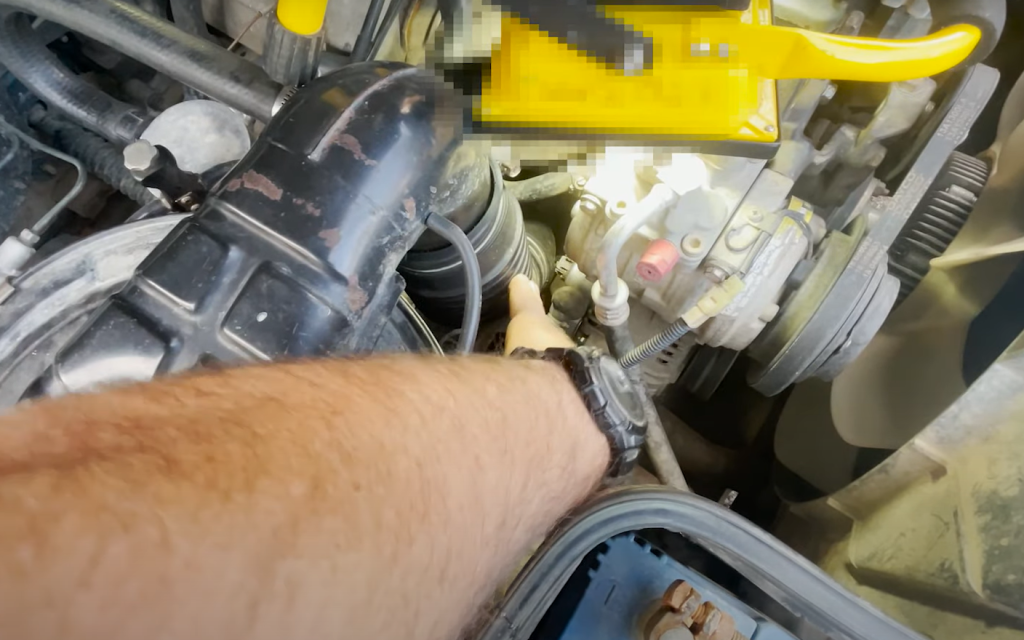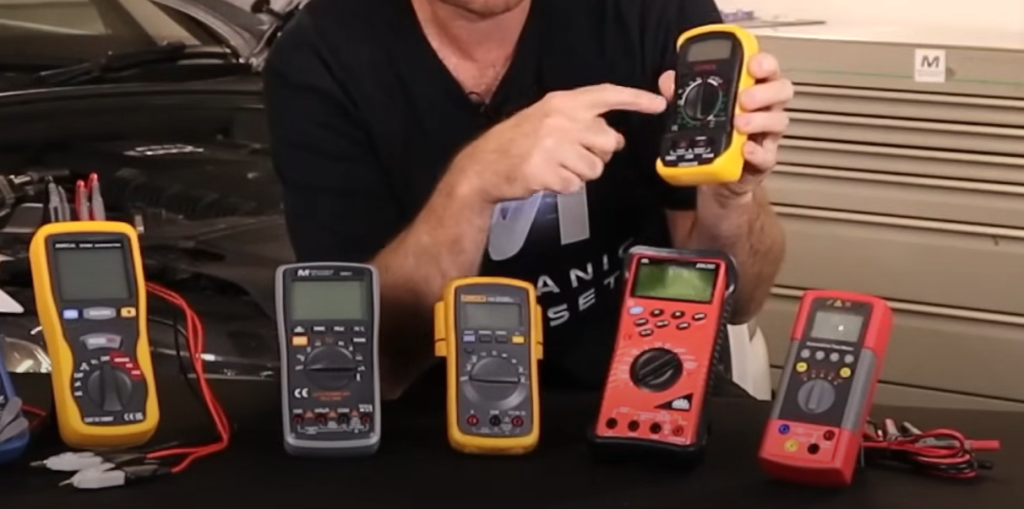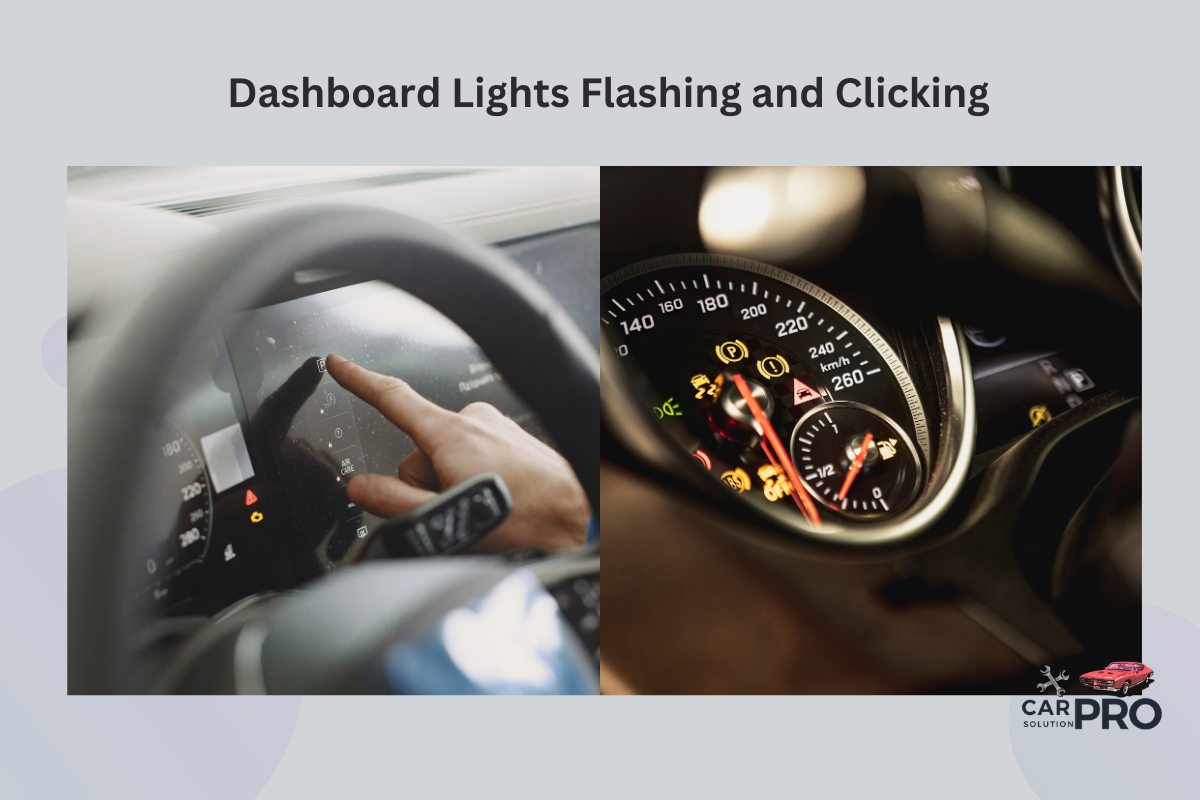When your car’s dashboard lights start flashing and clicking, it’s a sign that something isn’t right. This issue often points to problems with the electrical system or battery. A flashing dashboard with clicking sounds usually means your car’s battery is weak or the electrical system is failing.
Many drivers panic when they see flashing lights on their dash. It’s a common problem that can have several causes. The good news is that most of these issues are fixable.
Fixing this problem quickly is important. Ignoring it could lead to bigger, more expensive repairs down the road. Plus, it might leave you stranded if your car won’t start. Let’s look at why this happens and how to fix it.
Key Takeaways
- Flashing dashboard lights and clicking often mean a weak battery or failing electrical system
- Quick diagnosis and repair can prevent more serious car problems
- Regular car maintenance helps avoid unexpected electrical issues
Understanding Dashboard Lights
Dashboard lights are crucial indicators of your vehicle’s health and safety. They alert drivers to potential issues that need attention. Knowing what these lights mean can help prevent breakdowns and accidents.
Standard Dashboard Light Symbols and Meanings
Dashboard lights use different colors to show how urgent an issue is. Red lights often mean stop driving immediately. Yellow or orange lights suggest a problem needs checking soon. Green or blue lights typically show that a system is working normally.
Common symbols include the engine light, which looks like an engine outline. This can mean various engine problems. The battery light resembles a car battery and warns of charging system issues. An oil can symbol means low oil pressure or levels.
Other important lights are the brake system warning, airbag indicator, and tire pressure monitor. Each light has a specific meaning tied to a car system or safety feature.
Importance of Prompt Attention to Dashboard Alerts
Ignoring dashboard lights can lead to serious problems. A flashing check engine light means stop driving right away to prevent engine damage. Even steady warning lights need quick action to avoid costly repairs.
Some alerts, like low fuel or windshield washer fluid, are less urgent but still important. Others, like brake system warnings, are critical for safety. Responding quickly to dashboard alerts can prevent accidents and save money on repairs.
Regular car check-ups can catch issues before dashboard lights come on. This helps keep your car running smoothly and safely. If you’re unsure about a light’s meaning, check your owner’s manual or ask a mechanic for help.
Common Causes of Flashing Dashboard Lights

Flashing dashboard lights often point to issues with your car’s electrical system. These problems can range from minor to serious and may affect your vehicle’s performance and safety.
Electrical System Issues
Flickering dash lights can indicate problems with your car’s electrical system. Loose wires or damaged fuses are common culprits. A faulty ignition switch might also cause intermittent power supply to the dashboard.
Corroded battery terminals can disrupt the flow of electricity. This can lead to flickering lights and other electrical issues. Regular cleaning of battery terminals can help prevent this problem.
Ground wire problems can also cause electrical system malfunctions. A loose or damaged ground wire may not properly complete the electrical circuit, resulting in flickering lights.
Battery and Charging System Malfunctions
A weak or dying battery is a frequent cause of flashing dashboard lights. As the battery loses charge, it struggles to provide consistent power to the electrical components.
Voltage regulator issues can lead to inconsistent power supply. This component controls the amount of electricity flowing from the alternator to the battery. When it malfunctions, it can cause dashboard lights to flicker.
Loose battery connections can also result in intermittent power supply. This can cause dashboard lights to flash and may even prevent the car from starting.
Faulty Alternator or Starter
A failing alternator can cause dashboard lights to flicker. The alternator charges the battery and powers electrical systems while the engine runs. When it malfunctions, it may not provide steady power.
Worn alternator bearings or a loose alternator belt can cause inconsistent power generation. This can result in flickering dashboard lights and other electrical issues.
A faulty starter can also cause dashboard lights to flash. While primarily responsible for starting the engine, a malfunctioning starter can draw excessive power, affecting the entire electrical system.
Diagnosing the Issue
When dashboard lights flash and click, it’s crucial to pinpoint the cause. Proper diagnosis involves basic checks and may require advanced tools. Let’s explore the steps to identify the problem.
Initial Diagnostic Steps
Start by checking the battery. Weak batteries often cause flickering dash lights. Use a multimeter to test the battery voltage. A healthy battery should read around 12.6 volts when the car is off.
Next, inspect the alternator. A faulty alternator can lead to electrical issues. Look for loose or corroded connections at the battery and alternator.
Check fuses and relays. A blown fuse or faulty relay can cause dashboard problems. Consult your car’s manual to locate the fuse box and check for any blown fuses.
Examine wiring for visible damage. Frayed or chewed wires can cause electrical shorts, leading to dashboard issues.
Professional Diagnostic Tools and Techniques

Mechanics use specialized tools for in-depth diagnosis. An OBD-II scanner can read error codes from the car’s computer, helping identify specific issues.
Oscilloscopes allow technicians to view electrical signals in real-time. This helps detect intermittent electrical problems that might cause dashboard flashing.
Load testers can check the alternator’s output under different conditions. This test helps determine if the alternator is functioning correctly.
Professionals may also use advanced multimeters with additional features for precise electrical system testing. These tools can measure voltage drops and detect subtle electrical issues.
Solutions and Repairs
Fixing flashing and clicking dashboard lights often involves addressing electrical system issues. There are both DIY approaches and professional repair options available.
DIY Fixes and Precautions
Start by checking the battery connections. Clean any corrosion on the terminals using a wire brush. Tighten loose connections to ensure proper contact.
Test the battery voltage with a multimeter. A healthy battery should read around 12.6 volts when the car is off. If it’s below 12 volts, charge the battery or consider replacing it.
Inspect fuses in the fuse box. Look for any that are blown and replace them with fuses of the same amperage.
Check the alternator belt for wear or looseness. A failing alternator can cause dashboard lights to flicker. Tighten or replace the belt if needed.
If these steps don’t work, avoid further DIY attempts to prevent damage.
Seeking Professional Repair Services
When DIY fixes fail, it’s time to consult a professional mechanic. They have specialized tools to diagnose electrical problems accurately.
A mechanic can perform a thorough alternator test. This checks if it’s producing enough power to charge the battery and run electrical systems.
They can also inspect the starter motor. A faulty starter can cause clicking sounds and flickering lights when trying to start the car.
Professional diagnostics may reveal issues with the car’s computer or wiring harness. These complex problems require expert knowledge to fix safely.
Mechanics can also check for parasitic drains that might be depleting the battery when the car is off.
Preventive Measures
Taking care of your car’s electrical system can help avoid dashboard light issues. Regular upkeep and proper battery care are key to keeping your car running smoothly.
Regular Vehicle Maintenance and Inspections
Stick to your car’s service schedule. Get regular checkups from a trusted mechanic. They can spot small problems before they get bigger.
Check your car’s fuses and wiring. Look for any signs of wear or damage. Replace frayed wires right away.
Keep your battery connections clean. Dirty or loose connections can cause dashboard lights to flicker. Clean them with a wire brush and tighten any loose parts.
Test your alternator yearly. A faulty alternator can drain your battery and cause dash light problems. If it’s not charging properly, replace it.
Battery Maintenance and Longevity Tips
Check your battery’s charge level often. Use a voltmeter to test it. A healthy battery should read around 12.6 volts when the car is off.
Keep the battery clean and dry. Dirt and moisture can drain its power. Wipe it down with a cloth if it gets dirty.
Avoid short trips. Short drives don’t let the battery fully charge. Take longer drives now and then to keep it topped up.
In cold weather, use a battery blanket. This helps keep the battery warm and working well. Park in a garage if you can to protect it from extreme temps.
Replace your battery every 3-5 years. Old batteries are more likely to fail and cause electrical issues.
Frequently Asked Questions
Dashboard light flickering and clicking often stem from electrical system issues. Common culprits include battery problems, alternator faults, and loose connections. Understanding the causes can help drivers diagnose and fix these issues quickly.
What causes the headlights and dashboard lights to flicker when the car is running?
Flickering headlights and dashboard lights while the car is running usually point to alternator problems. The alternator may not be producing enough power to keep the electrical system stable.
Loose battery connections can also cause flickering. Check the battery terminals for corrosion or loose fittings.
How can I troubleshoot a flickering dashboard light issue?
Start by checking the battery connections. Clean any corrosion and tighten loose terminals.
Test the battery voltage. A healthy battery should read around 12.6 volts when the car is off. If it’s low, charge or replace the battery.
Inspect the alternator belt for wear or looseness. A slipping belt can cause power fluctuations.
Why won’t my car start even though the dashboard lights are flickering?
A car that won’t start with flickering dash lights often has a dead or dying battery. The battery may have enough power to run some electronics but not enough to start the engine.
A faulty alternator can also cause this issue. It may not have charged the battery enough during previous use.
Can a vehicle’s starting problems be related to flickering dash lights?
Yes, starting problems and flickering dash lights are often connected. Both can be symptoms of electrical system issues.
A weak battery or failing alternator can cause flickering lights and starting difficulties. These components are crucial for providing power to start the engine and run electrical systems.
What are the common reasons for clicking sounds accompanying dashboard light flickering?
Clicking sounds with flickering lights often indicate a weak battery. The battery may not have enough power to engage the starter motor fully.
A failing starter motor can also cause clicking. If the starter can’t turn the engine over, it may produce rapid clicking noises.
How does a bad alternator lead to flickering of dashboard lights?
A bad alternator can’t produce stable electrical output. This leads to voltage fluctuations in the car’s electrical system.
As the voltage varies, the dashboard lights may dim or brighten. This flickering effect becomes more noticeable as the alternator’s condition worsens.


